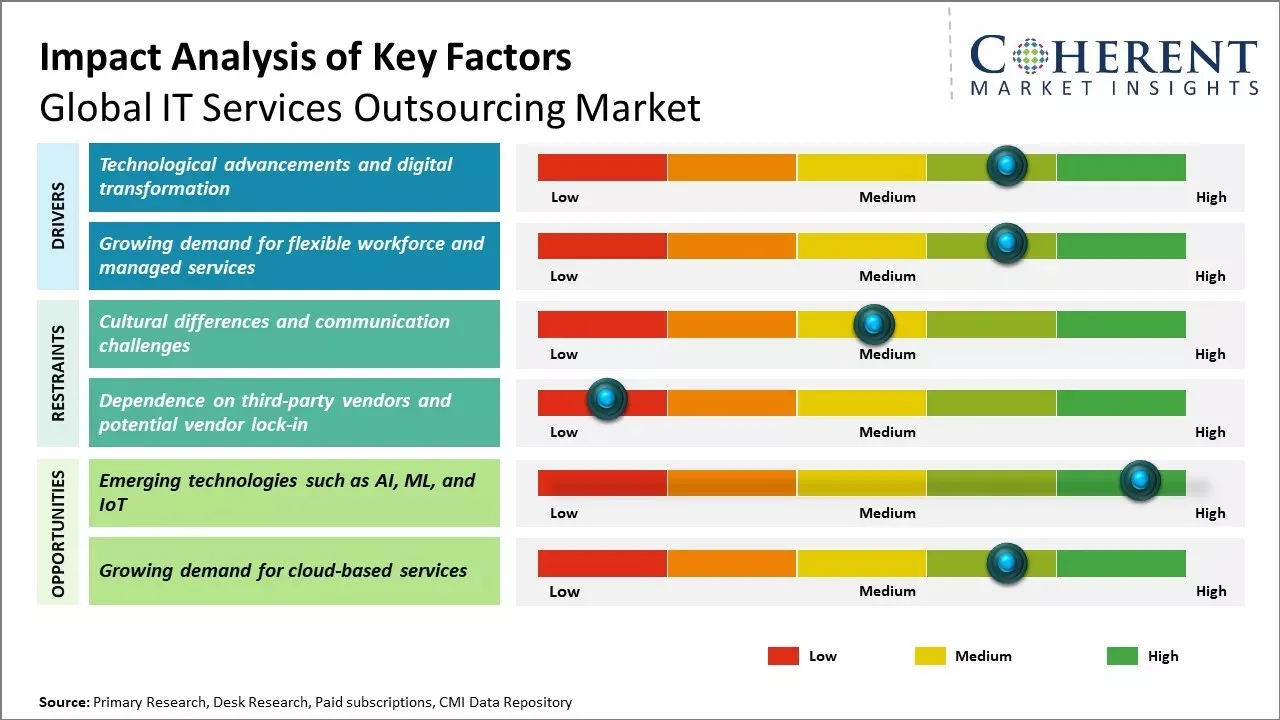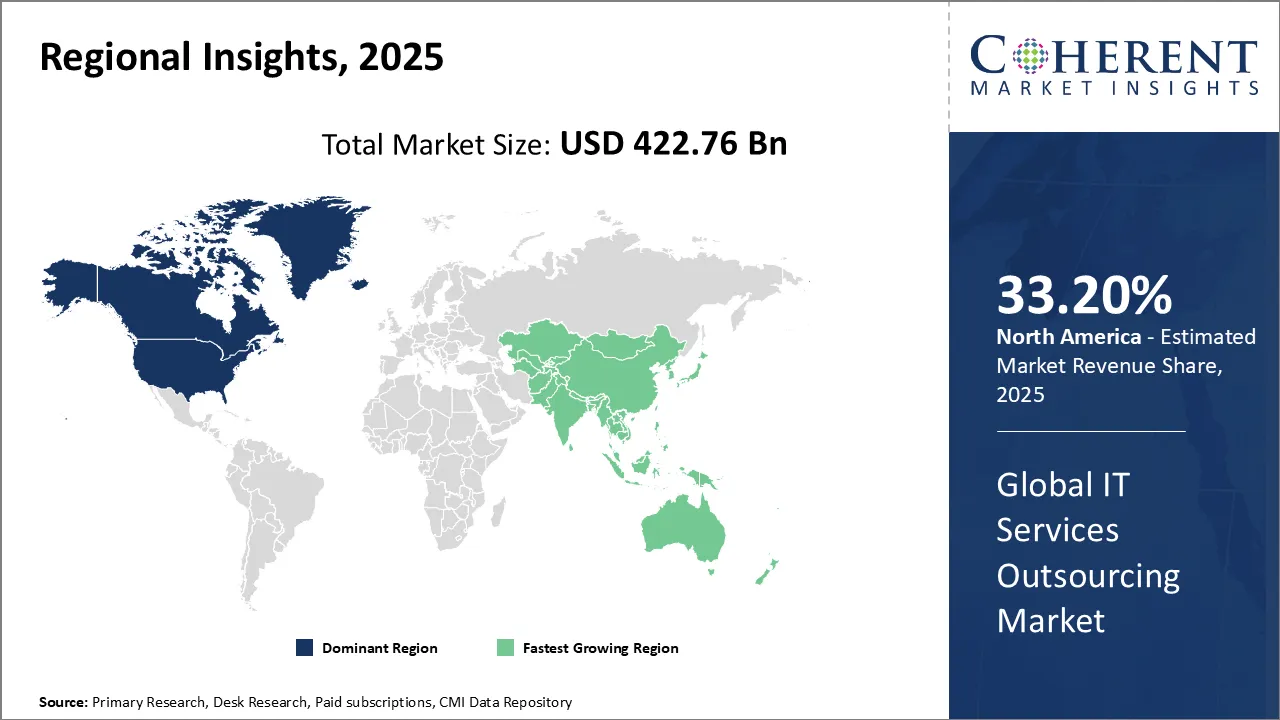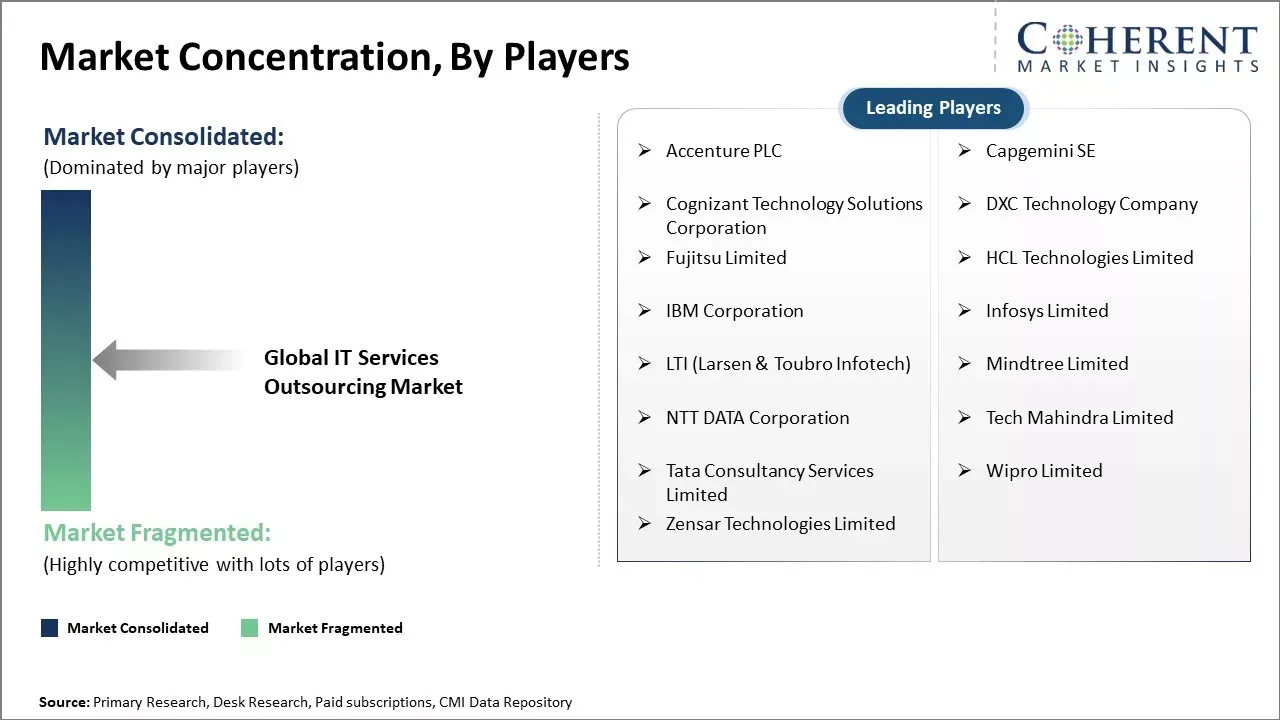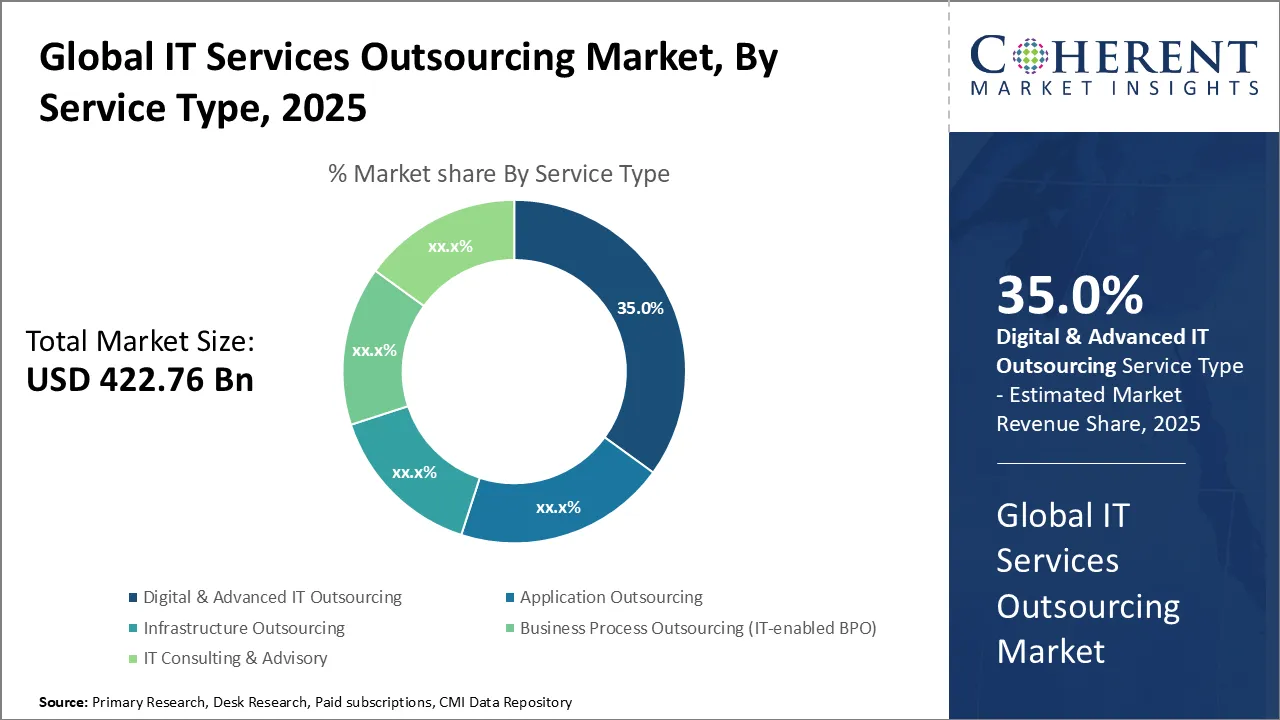IT Services Outsourcing Market Size and Trends - 2025 to 2032
Global IT services outsourcing market is estimated to be valued at USD 422.76 Bn in 2025 and is expected to reach USD 778.29 Bn by 2032, exhibiting a compound annual growth rate (CAGR) of 9.1% from 2025 to 2032.
Key Takeaways
- Based on Service Type, the Digital & Advanced IT Outsourcing segment is expected to lead with 35% share in 2025, with cloud, cybersecurity, and AI driving enterprise transformation.
- Based on Sourcing Model, the Offshore Outsourcing segment is expected to hold the largest share of the market in 2025, leveraging Asia-Pacific talent and cost efficiency for global IT delivery.
- Based on Engagement Model, the Managed Service segment is projected to account for the highest share of the market in 2025, offering long-term, end-to-end IT management with predictable costs and innovation.
- Based on Contract Duration, the Mid-term contract (1-3 years) segment is projected to capture the market with greatest share in 2025, balancing flexibility with stability in fast-changing tech landscapes.
- Based on Enterprise Size, the Large Enterprise segment is expected to lead with the largest share of the market in 2025, driving demand for scalable, secure, and advanced IT outsourcing solutions.
- Based on End-Use Industry, the BFSI segment is expected to hold the highest share of the market in 2025, for digital banking, compliance, cybersecurity, and enhanced customer experiences.
- Based on Region, North America is set to lead the IT services outsourcing market with 33.2% share in 2205. While, Asia Pacific is anticipated to be the fastest growing.

To learn more about this report, Download Free Sample
Market Overview
With increasing globalization of businesses, more companies are outsourcing their IT services such as infrastructure management and support to lower costs and focus on their core operations, the market is expected to witness significant growth during the forecast period. The key drivers of this market include focus on core competencies, access to advanced technologies, scalability, and cost optimization. There is rising demand for outsourcing application development and maintenance services, especially among small and medium enterprises. Growing penetration of cloud-based technologies and automation are also expected to boost the IT services outsourcing market.
Current Events and Its Impacts on the IT services Outsourcing Market
|
Current Event |
Description and its Impact |
|
Artificial Intelligence and Automation Revolution |
|
|
Regulatory and Data Privacy Landscape Changes |
|
Uncover macros and micros vetted on 75+ parameters: Get instant access to report
AI-Powered Outsourcing
- Adoption in Outsourcing Contracts
- 40–50% of new outsourcing agreements in 2025 include AI automation clauses, according to industry contracting reports.
- AI is no longer a pilot project, 62% of enterprises are experimenting or scaling AI agents to automate workflows.
- High-performing companies report up to 39% EBIT impact from AI integration, showing tangible financial benefits.
- Efficiency Gains
- AI reduces manual workloads by 25–30%, particularly in repetitive tasks like payroll, compliance checks, and customer query handling.
- Outsourcing providers using AI report 20–25% faster turnaround times in HR and finance processes.
- AI-driven customer support bots resolve 60–70% of queries without human intervention, cutting costs by 15–20%.
- Cost Savings
- Enterprises outsourcing with AI save 15–30% in operational costs compared to traditional outsourcing models.
- AI-enabled outsourcing contracts often include performance-based pricing, aligning vendor fees with efficiency gains.
- In finance outsourcing, AI reduces error rates by up to 40%, lowering compliance penalties and rework costs.
- Industry-Specific Impact
- HR Outsourcing: AI automates recruitment screening, payroll, and compliance, reducing HR processing costs by 25%.
- Finance Outsourcing: AI-driven auditing and fraud detection improve accuracy by 30–40%, cutting manual review time.
- Customer Support Outsourcing: AI chatbots and voice assistants handle millions of queries, reducing call center staffing needs by 20–25%.
- Strategic Trends
- AI Agents: Outsourcing contracts increasingly include agentic AI, systems that autonomously perform extended tasks with minimal human oversight.
- Global Demand: Outsourcing providers in India, Eastern Europe, and Latin America are embedding AI into contracts to stay competitive.
- Risk Management: AI improves compliance monitoring, reducing outsourcing risks in regulated industries like healthcare and banking.
IT services Outsourcing Market Insights, By Service Type: Digital & Advanced IT Outsourcing Leads with Cloud, Cybersecurity, And AI Driving Enterprise Transformation
in terms of service type, the digital & advanced IT outsourcing segment is expected to lead with 35% share of the market in 2025, driven by cloud adoption, cybersecurity needs, and AI integration. Enterprises prioritize scalable cloud managed services, proactive cyber defense, and predictive analytics. DevOps and platform engineering streamline innovation, making this segment the backbone of digital transformation across industries worldwide.
For instance, in December 2025, AppZen released AI Agent Studio, a platform that allows businesses use AI-powered agents for financial tasks. The solution automates auditing expenses, making sure they are legal, and managing workflows. This reduces manual work and makes things run more smoothly. The launch shows that there is a growing need for digital and advanced IT outsourcing, especially AI-powered business services.
IT services Outsourcing Market Insights, By Sourcing Model: Offshore Outsourcing Dominates, Leveraging Asia-Pacific Talent and Cost Efficiency for Global IT Delivery
In terms of sourcing model, the offshore outsourcing segment is expected hold the largest share of the market in 2025, due to cost efficiency, global talent pools, and 24/7 service delivery. Asia-Pacific hubs like India and the Philippines remain preferred destinations. Enterprises leverage offshore providers for application development, cloud management, and cybersecurity, balancing affordability with expertise, while hybrid models supplement collaboration for sensitive or strategic projects.
For instance, in October 2025, Hire Velocity started an Offshore Recruitment Process Outsourcing service to help businesses make hiring people from other countries easier. The service uses offshore delivery centers to offer affordable hiring solutions. This move highlights the significance that offshore outsourcing is becoming in IT-enabled BPO, especially for big companies that want to be more efficient and flexible.
IT services Outsourcing Market Insights, By Engagement Model: Managed Services Prevail, Offering Long-Term, End-To-End IT Management with Predictable Costs and Innovation
In terms of engagement model, the managed services segment is projected to account for the highest share of the market in 2025, as enterprises seek long-term, end-to-end IT partnerships. Providers deliver continuous monitoring, cloud operations, cybersecurity, and infrastructure management. This model ensures predictable costs, service-level agreements, and innovation support. Businesses prefer managed services over project-based outsourcing, valuing stability, scalability, and proactive IT management in a rapidly evolving digital landscape.
For instance, in November 2025, Gartner named Kyndryl a leader in Data Center Outsourcing and Hybrid Infrastructure Managed Services. The award highlights its strength in providing managed IT services, such as cloud integration and infrastructure operations. This strengthens its position as a trusted outsourcing partner for large businesses around the world in 2025.
IT services Outsourcing Market Insights, By Contract Duration: Mid-Term Contracts (1–3 Years) Dominate, Balancing Flexibility with Stability in Fast-Changing Tech Landscapes
In terms of contract duration, the mid-term contracts segment is projected to capture the greatest share of the market in 2025, offering flexibility and stability. Enterprises avoid long-term commitments due to fast-changing technologies like AI and cloud. Short-term contracts lack depth, while mid-term agreements balance adaptability with strategic alignment. This duration allows providers to deliver transformation projects while enabling clients to renegotiate terms as technology evolves.
For instance, in June 2025, India's largest IT services exporters, like TCS, Infosys, Wipro, and HCLTech, have signed multi-year outsourcing contracts. These long-term deals keep revenue steady and give clients peace of mind. They show that India's IT sector is strong due to companies keep investing in long-term digital transformation partnerships.
IT services Outsourcing Market Insights, By Enterprise Size: Large Enterprises Lead Spending, Driving Demand for Scalable, Secure, And Advanced IT Outsourcing Solutions
In terms of enterprise size, the large enterprises segment is expected to acquire the dominating share in 2025, driven by global operations, complex IT needs, and digital transformation mandates. They invest heavily in cloud, cybersecurity, and AI outsourcing. SMEs increasingly adopt outsourcing for cost savings, but large enterprises remain the primary drivers, shaping demand for advanced, scalable, and secure IT services.
For instance, in April 2025, Digital Workforce signed a multi-year deal with an established industrial company to handle its intelligent automation operations. The deal includes AI-driven workflows and robotic process automation, which make things more efficient and scalable. This partnership shows that more and more big companies in the industrial sector around the world want to outsource their IT work to experts.
IT services Outsourcing Market Insights, By End Use Industry: BFSI Dominates, Outsourcing IT For Digital Banking, Compliance, Cybersecurity, And Enhanced Customer Experiences
In terms of end use industry, the BFSI segment is expected to lead with largest share of the market in 2025, fueled by digital banking, fintech innovation, and strict regulatory compliance. Banks and insurers outsource cybersecurity, cloud, and analytics to enhance customer experience and safeguard data. The sector’s reliance on IT outsourcing ensures resilience, efficiency, and competitive advantage in a highly regulated, technology-driven environment.
For instance, in April 2023, the Reserve Bank of India has set new rules for banks that want to outsource their IT services. When hiring third-party vendors for cloud, cybersecurity, and application support, the rules require strict risk management, accountability, and compliance. Banks are still fully responsible for outsourced tasks, making sure that data is safe and that rules are followed.
Regional Insights

To learn more about this report, Download Free Sample
North America IT services Outsourcing Market Analysis & Trends
The North America region continues to dominate the global IT services outsourcing market with 33.2% share in 2025 owing to a well-established technology infrastructure and a conducive business environment. With abundant availability of skilled workforce and technology talent, countries like the U.S. and Canada have emerged as major sourcing hubs for IT services. Proximity to client locations and shared time zones allow seamless collaboration and prompt issue resolution.
For instance, in January 2025, Clarion Technologies released an IT Outsourcing ROI Calculator to help leaders figure out the amount of money they can save by outsourcing. The tool makes it clear how much money can be saved, the more effective things can be, and just how much strategic value outsourcing can bring. This helps decision-makers better evaluate outsourcing partnerships and make choices based on data that ensures they get the most out of IT services partnerships.
Aisa Pacific IT services Outsourcing Market Analysis & Trends
Meanwhile, the Asia Pacific region has emerged as the fastest growing IT Services Outsourcing Market. Countries like India, China, the Philippines, and Vietnam offer attractive pricing benefits due to lower cost of operations and workforce. The mature IT infrastructure along with government initiatives to promote technology adoption have made nations in the Asia Pacific region an attractive outsourcing destination.
For instance, in October 2025, Cognizant released two AI-powered tools designed to assist small and medium-sized businesses grow faster across the APAC region. These services make things run more smoothly, get customers more involved, and make things more efficient. As outsourced IT-enabled services, they help small and medium-sized businesses take advantage of advanced digital transformation without having to spend considerable amounts of money on in-house staff. This strengthens Cognizant's position as a leader in global IT services outsourcing.
IT services Outsourcing Market Outlook Country-Wise
The U.S. IT services Outsourcing Market Trends
In 2025, the U.S. IT outsourcing market is demanding due to rising digital transformation, cloud adoption, and AI integration. Companies seek cost efficiency, cybersecurity expertise, and scalable IT solutions. Outsourcing enables access to specialized talent, supports innovation, and helps enterprises remain competitive in a rapidly evolving technology landscape.
For instance, in December 2025, In San Jose, California, AppZen launched AI Agent Studio, which allows digital coworkers automate finance tasks. The platform transforms the way outsourcing works by letting companies do tasks like expense audits and compliance in-house instead of relying on outside providers. This new idea changes the ways IT services are outsourced by making them more efficient and easier to control with AI.
India IT services Outsourcing Market Trends
India's IT outsourcing market is expected to remain competitive in 2025 since it is cost-effective, has a large pool of skilled workers, and the world depends on digital transformation. Rising needs for AI-driven automation, cybersecurity, and cloud services attract investments, reinforcing India’s role as the preferred hub for advanced IT outsourcing solutions worldwide.
For instance, in October 2025, India’s IT sector aims to reach $400 billion by 2030, driven by AI innovation and global outsourcing demand. With strengths in software, infrastructure, and digital transformation, India remains the leading outsourcing hub. AI adoption enhances efficiency, reinforcing its role as a global IT services outsourcing powerhouse.
Market Report Scope
IT Services Outsourcing Market Report Coverage
| Report Coverage | Details | ||
|---|---|---|---|
| Base Year: | 2024 | Market Size in 2025: | USD 422.76 Bn |
| Historical Data for: | 2020 To 2024 | Forecast Period: | 2025 To 2032 |
| Forecast Period 2025 to 2032 CAGR: | 9.1% | 2032 Value Projection: | USD 778.29 Bn |
| Geographies covered: |
|
||
| Segments covered: |
|
||
| Companies covered: |
Accenture, IBM Consulting, Tata Consultancy Services (TCS), Infosys, Cognizant, Capgemini, Wipro, HCLTech, DXC Technology, Atos, NTT DATA, and Tech Mahindra |
||
| Growth Drivers: |
|
||
| Restraints & Challenges: |
|
||
Uncover macros and micros vetted on 75+ parameters: Get instant access to report
IT Services Outsourcing Market Driver
Technological advancements and digital transformation
With technology advancing at an ever-increasing rate, it has become almost impossible for organizations to keep up with the latest innovations on their own. There is constant change in areas such as cloud computing, mobility, analytics, automation, Blockchain, and artificial intelligence. Moreover, customers are demanding improved digital services and experiences. Organizations are under pressure to quickly adopt new technologies and digital business models in order to remain competitive. This is driving greater reliance on IT services providers that have specialist skills and can help accelerate digital transformation journeys.
Outsourcing non-core technology functions such as infrastructure management, application development and support allows companies to focus internal resources on their core competencies. IT service providers invest heavily in research and building centers of excellence to stay ahead of the technology curve. They have the capabilities and expertise to integrate new technologies seamlessly into clients’ systems and operations. Particularly for newer and emerging technologies, outsourcing reduces the risks associated with in-house development and implementation. Service providers effectively share the costs and responsibilities of continuously evolving technology landscapes with their clients.
For instance, in February 2023, Oracle, a leading cloud technology company, launched Oracle Banking Cloud Services, a new suite of cloud-native, software-as-a-service (SaaS) solutions for the banking industry. This componentized and composable suite of services is designed to help corporate and retail banks modernize their applications and meet customer demands with agility. The services can be selected and combined to create tailored solutions that address each bank's unique requirements, enabling them to innovate with speed, security, and scale without compromising their existing environments.
Growing Demand for Flexible Workforce and Managed Services
Rather than maintaining expensive in-house IT teams to handle various tasks, many companies now prefer outsourcing non-core IT functions. This provides operational flexibility and reduces fixed costs. Global capability centers of IT service providers can scale resources up or down instantly based on changing business demands. Their workforce is trained and certified on a wide range of technologies, with different skill levels available on an as-needed basis.
Outsourcing frees internal teams to focus on strategic priorities instead of routine maintenance and support activities. IT service vendors offer managed services for applications, infrastructure and security through shared services models. They closely monitor clients’ IT environments using advanced tools and take care of ongoing operations, upgrades and issues reported. This streamlines processes, improves service quality through specialized management skills and frees clients’ employees for more critical tasks. It also removes resource and budget planning uncertainties related to in-house maintenance of ageing systems.
Furthermore, managed services pricing is mostly aligned to actual usage rather than large upfront capital investment and operating expenditures. This subscription or pay-per-use pricing makes IT costs highly predictable and visible. IT outsourcing models like cloud and "as-a-service" suit cash-strapped industries in the current uncertain macroeconomic conditions. They allow optimizing existing investments before incurring new expenses for IT modernization programs. Overall, the growing requirement for variable workforce and managed services delivery is a significant factor propelling increased IT outsourcing globally.
Market Concentration and Competitive Landscape

To learn more about this report, Download Free Sample
Analyst Opinion (Expert Opinion)
The IT services outsourcing market continues to expand in scale and strategic relevance, driven by enterprise-wide digital transformation, cloud migration, and the operationalization of artificial intelligence. Independent industry assessments consistently put the market's annual spending in the high hundreds of billions of dollars. This shows the maturity and deep it is in application development, infrastructure management, cloud operations, and IT-enabled services.
Demand is increasingly shaped by data-driven priorities. Enterprise technology surveys indicate that more than half of organizations actively deploy cloud platforms and AI-enabled tools, positioning outsourcing partners as execution engines for modernization, automation, and cost optimization. Large service providers are responding by making significant investments in AI-assisted delivery models, low-code platforms, and proprietary accelerators. These are already making delivery easier and more consistent.
Offshore and nearshore delivery hubs are still important to global sourcing strategies because they have large, skilled workforces and established vendor ecosystems. At the same time, regulatory requirements around data localization and cybersecurity are prompting greater use of regional delivery centers, particularly in regulated industries such as financial services and healthcare.
Competitive dynamics favor vendors that combine scale with platform-based offerings and outcome-oriented pricing. Buyers are increasingly evaluating providers on total cost of ownership, automation capability, and measurable business impact rather than purely on labor rates. Overall, the market is transitioning from labor-centric outsourcing toward technology-enabled, value-focused partnerships.
Recent Developments
- In June 2025, Simplify Healthcare partnered with Atento to launch Business Transformation Outsourcing (BTO), enhancing healthcare member experiences through digital platforms, automation, and IT-enabled services. The collaboration integrates technology-driven processes to improve efficiency, scalability, and engagement, positioning both firms as leaders in outsourcing solutions tailored to healthcare’s evolving needs and global demands.
- In May 2025, ISG announced that it would add AI to its HR outsourcing services to make them better, which would make managing a workforce more efficient and automated. By embedding AI into HR processes like compliance and decision-making, outsourcing providers deliver smarter, faster solutions. This development ties directly to IT-enabled outsourcing, reshaping global HR services through advanced digital platforms and innovation.
- In April 2025, Systex Group started Systex Asia to grow in Southeast Asia and improve IT services around the world. The goal of the project is to provide outsourced solutions in the areas of cloud computing, AI, and digital transformation. Systex positions itself as a strategic outsourcing partner by focusing on regional demand. This speeds up growth in the APAC IT services market.
Market Segmentation
- By Service Type Insights
- Application Outsourcing
- Application Development
- Application Maintenance & Support
- Infrastructure Outsourcing
- Data Center Services
- Network Management
- End-User Computing Services
- Business Process Outsourcing (IT-enabled BPO)
- Finance & Accounting (F&A)
- HR Outsourcing (HRO)
- Customer Support
- Digital & Advanced IT Outsourcing
- Cloud Managed Services
- Cybersecurity Services
- Data Analytics & AI Services
- DevOps & Platform Engineering
- IT Consulting & Advisory
- IT Strategy & Transformation
- System Integration (SI)
- Application Outsourcing
- By Sourcing Model Insights
- Onshore Outsourcing
- Nearshore Outsourcing
- Offshore Outsourcing
- Hybrid Delivery Model
- By Engagement Model Insights
- Project-Based Outsourcing
- Managed Services
- Staff Augmentation
- Performance-Based Contracts
- By Contract Duration Insights
- Short-Term Contracts (< 1 Year)
- Mid-Term Contracts (1–3 Years)
- Long-Term Contracts (> 3 Years)
- By Enterprise Size Insights
- Large Enterprises
- Small & Medium Enterprises (SMEs)
- By End-Use Industry Insights
- BFSI (Banking, Financial Services & Insurance)
- IT & Telecom
- Healthcare & Life Sciences
- Manufacturing
- Retail & E-commerce
- Energy & Utilities
- Government & Public Sector
- Media & Entertainment
- Transportation & Logistics
- Regional Insights
- North America
- U.S.
- Canada
- Latin America
- Brazil
- Argentina
- Mexico
- Rest of Latin America
- Europe
- Germany
- U.K.
- Spain
- France
- Italy
- Russia
- Rest of Europe
- Asia Pacific
- China
- India
- Japan
- Australia
- South Korea
- ASEAN
- Rest of Asia Pacific
- Middle East
- GCC Countries
- Israel
- Rest of Middle East
- Africa
- South Africa
- North Africa
- Central Africa
- North America
- Key Players Insights
- Accenture
- IBM Consulting
- Tata Consultancy Services (TCS)
- Infosys
- Cognizant
- Capgemini
- Wipro
- HCLTech
- DXC Technology
- Atos
- NTT DATA
- Tech Mahindra
Sources
Primary Research Interviews
- IT Services Outsourcing Providers
- Managed Services & Cloud Service Providers
- Software Development & Application Management Vendors
- CIOs, CTOs & IT Decision-Makers (Enterprises & SMEs)
- Digital Transformation & IT Strategy Consultants
- Others
Databases
- Bloomberg Terminal
- Thomson Reuters Eikon
- S&P Global Market Intelligence
- IDC Data & Analytics
- Statista
- Others
Magazines
- CIO Magazine
- InformationWeek
- Computerworld
- TechCrunch
- Others
Journals
- Journal of Information Technology
- MIS Quarterly
- IEEE Software
- International Journal of Information Management
- Others
Newspapers
- Financial Times
- The Wall Street Journal
- The Economic Times
- Reuters
- Others
Associations
- National Association of Software and Service Companies (NASSCOM)
- International Association of Outsourcing Professionals (IAOP)
- Information Systems Audit and Control Association (ISACA)
- Cloud Security Alliance (CSA)
- Others
Public Domain Sources
- World Bank – Digital Development Reports
- OECD – ICT & Digital Economy Outlook
- U.S. Bureau of Labor Statistics (IT Services Data)
- European Commission – Digital Economy & Society Index (DESI)
- Government IT & Digital Transformation Portals
- Others
Proprietary Elements
- CMI Data Analytics Tool
- Proprietary CMI Existing Repository of Information for the Last 8 Years
Share
Share
About Author
Ankur Rai is a Research Consultant with over 5 years of experience in handling consulting and syndicated reports across diverse sectors. He manages consulting and market research projects centered on go-to-market strategy, opportunity analysis, competitive landscape, and market size estimation and forecasting. He also advises clients on identifying and targeting absolute opportunities to penetrate untapped markets.
Missing comfort of reading report in your local language? Find your preferred language :
Transform your Strategy with Exclusive Trending Reports :
Frequently Asked Questions
EXISTING CLIENTELE
Joining thousands of companies around the world committed to making the Excellent Business Solutions.
View All Our Clients

